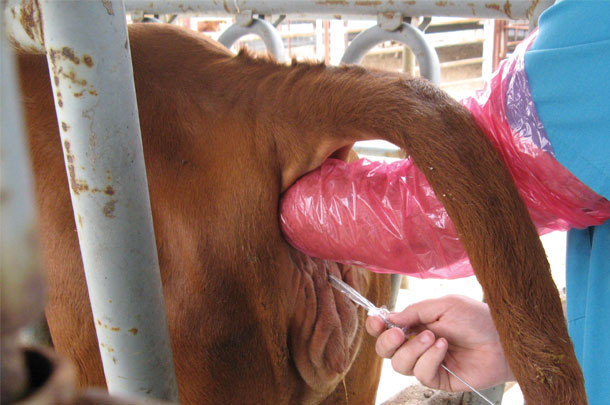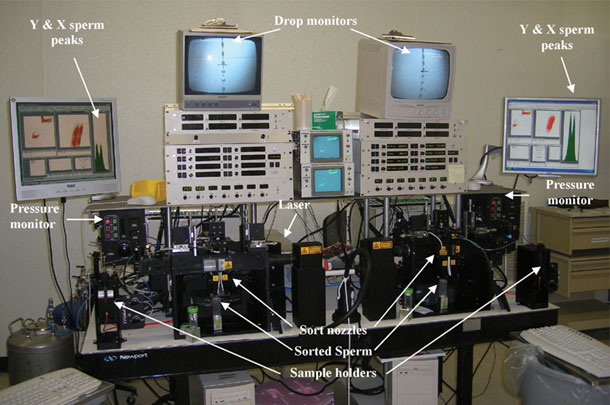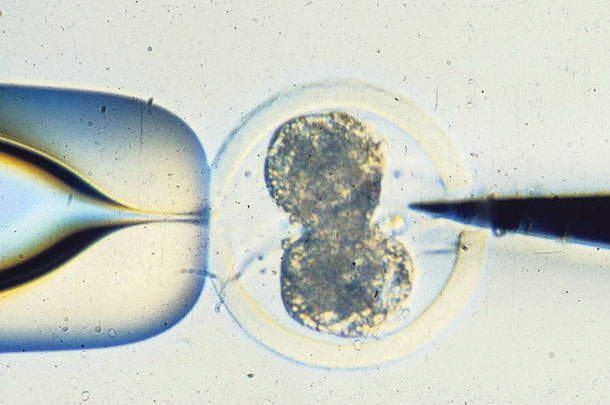In order to keep step with the increasing number of people, livestock producers must continue to improve operation efficiency through early adoption of new production methods.
An amazing amount of new animal science technology is being developed by universities, industry and research organizations on a daily basis, and beef cattle reproduction is no exception.
The reproduction technology discussed in this article has been available for years but is currently uneconomical for cow-calf producers. Exceptions are estrus synchronization, A.I. and perhaps embryo transfers (ET) that offer producers opportunities to rapidly improve genetics at reasonable costs.
Estrus synchronization and A.I.

“The first step in taking advantage of the opportunity to improve breeding economics is to adopt estrus synchronization as a way to shorten the calving season,” says Glenn Rogers, DVM, owner and operator of Holt River Ranch and Grassy Ridge Consulting.
“An advantage of estrus synchronization is more calves born earlier in the calving season, resulting in heavier weaning weights. It also allows for more efficient use of labor during calving season. Estrus synchronization is necessary for efficient use of A.I.
“Cow-calf operators might want to consider A.I. because of the ability to enhance herd genetics more economically than buying the same-quality bulls,” Rogers continues.
“A.I. provides a high accuracy of sire expected progeny differences (EPDs) such as calving ease and allows the use and maintenance of fewer bulls.”
Embryo Transfer
Embryo Transfer, or ET, is the process of removing one or more embryos (fertilized eggs) from the reproductive tract of a donor female and transferring them to one or more recipient female. The entire process involves breeding a donor cow (usually by A.I.), flushing embryos from the donor and injecting embryos into recipient cows.
The advantage of this practice is that it allows transfer of maternal traits from a super-cow to several recipients, resulting in more calves with the improved genetics.
“To maximize embryo survival in the recipient female following transfer, conditions in the recipient reproductive tract should closely resemble those in the donor,” says Tom Troxel, Ph.D., University of Arkansas Division of Agriculture Research and Extension.
“This requires synchronization of the estrous cycles between the donor and the recipients, optimally within one day of each other."
“Superovulation is the release of multiple eggs at a single estrus,” explains Troxel. “Cows properly treated can release as many as 10 or more viable eggs at one estrus. Approximately 85 percent of all normal fertile donors will respond to superovulation treatment with an average of five transferable embryos.”
Sexed semen
“A.I. and estrus synchronization are the foundation for other breeding concepts,” said George Seidel, Ph.D., Colorado State University, at the 2015 Cattle Industry Convention and NCBA Trade Show. “This is especially true for sexed semen because it cannot be used without A.I. Sexed semen is now being produced commercially in a number of countries, including the U.S.

Positive aspects of this technology are accuracy of sexing sperm close to 90 percent with large sample sizes, and the calves produced appear to be normal.
The main negatives are sexed semen is expensive, fertility of sexed sperm is somewhat lower than unsexed sperm, and this product currently is only available from relatively few sires, especially beef breeds. It is possible to get semen sexed and frozen on a custom basis.
“The largest cost of sexed semen is lower fertility. There are two primary reasons for lower fertility: Fewer sperm are used per straw, typically 2 million compared to 20 million or more sperm for most bulls with unsexed semen, and sperm are slightly damaged by current sexing procedures, so they do not swim quite normally.
“The extent of lowered fertility is about 10 percent under ideal conditions such as good nutrition, well-trained inseminators, excellent heat detection and very careful handling of semen.
Under average conditions, fertility of sexed sperm is about 70 percent of the fertility of unsexed sperm. For example, if unsexed semen from a particular bull in a particular herd results in 60 percent pregnant cows, the pregnancy rate for sexed sperm can be 70 percent x 60 percent = 42 percent.
Note these are the results for A.I. 12 to 24 hours after clear standing estrus; they will be even lower for timed-A.I. protocols. Sexed semen usually leads to disastrously low pregnancy rates under less-than-average conditions.
“In my opinion, the logical place to use sexed semen is breeding replacement heifers to produce more replacement heifers,” Seidel continued.
“These heifers often will be bred A.I. anyway, and there are several added bonuses: less calving difficulty if they have heifer calves rather than larger bull calves, the replacement heifers should have the best genetics in the herd, and this allows breeding cows to deliver terminal-cross calves; since few replacements need to come from the cow herd, most can come from A.I.’d first-calf heifers.”
In-vitro fertilization (IVF)
“ET provides the foundation for in-vitro fertilization,” said Seidel. “There are two methods of IVF – conventional and intracytoplasmic sperm injection (ICSI).”
“Conventional IVF procedure involves creating embryos from unfertilized egg cells (oocytes) by fertilizing them with semen in a Petri dish,” explains Mark Allan, Trans Ova Genetics director of marketing and genomics.
“A trained technician or veterinarian collects oocytes from a donor cow using an ultrasound-guided aspiration known as the Ovum Pick Up (OPU) technique. The oocytes are placed in the Petri dish and fertilized the following day with semen. The fertilized eggs mature in an incubator for seven days, and the resulting viable embryos are transferred into recipient cows.
“IVF has some advantages over ET, although it is slightly more expensive,” Allan continues. “A single straw of semen may be used to fertilize one to five donors’ oocytes through IVF."
"With ET and superovulation techniques, the technician generally uses three to four straws of semen per donor cow. Donor cows in an active ET program must be open, while IVF technology allows the donor cow to provide embryos from day 40 to day 100 of gestation.”
“ICSI is a process of injecting the sperm directly into the oocyte,” said Seidel. “This process provides the capability for rescuing semen that has lost motility, but its genetic material is not damaged."
"ICSI is now used routinely for human infertility cases in which the husband’s sperm are fairly normal except for motility characteristics. At Colorado State University, we also use the procedure routinely for stallions with the same problem. I call ICSI ‘fertilization by brute force’.”
Split embryos

“For splitting, embryos are recovered from a donor cow by flushing,” Seidel explained. “The embryo is then sliced in two with equipment consisting of an inverted microscope and an electronically controlled micromanipulator, which holds an ultra-sharp splitting blade. Embryo halves can be transferred either singly or as twins to recipient females.
The advantage of this technique is that you get two calves instead of one, and the number of live offspring obtained from an ET program can be significantly increased.
Use of embryo sexing allows producers to concentrate their genetic improvement on either their superior male or female lines and to dramatically reduce the overall cost of embryo transfer by eliminating 50 percent of recipients.”
Another advantage of embryo splitting is that it allows separation of cells to determine if they are normal. The abnormal cells can be destroyed, and the remaining embryo with normal cells can be transferred to a recipient.
“Most embryo splitting has been done with cattle, resulting in delivery of thousands of calves,” Seidel continued. “The practice is not widely used today because of the extra work required for splitting. A very small amount of embryo splitting has been performed in horses, and it is extremely rare in humans.”
Cloning
“There are many definitions of cloning and many methods of cloning,” said Seidel. “Cloning of potential practical value occurs when copying a genetically outstanding animal."
This usually is done by taking a very small biopsy of skin from the animal to be cloned, growing some of the skin cells in plastic dishes in an incubator and using nuclei of those cells as the genetic material for the clones.
Other body cells also can be used, such as hair roots or somatic cells in milk or semen. Usually, the donor cells are frozen in liquid nitrogen and thawed when the cloning step is done.
This method of cloning is often termed somatic cell nuclear transfer (SCNT) because somatic (body) cells are used instead of germline cells such as sperm, eggs and early embryos.
“SCNT is not a very practical procedure for many reasons,” Seidel continued. “First, success rates are very low, making it very expensive. In addition to the expensive equipment needed, plus the services of skilled personnel, many embryos must be transferred, using many recipients to produce few pregnancies."
"Oocytes must be obtained from slaughterhouse ovaries or via transvaginal aspiration from ovaries of follicle-stimulating hormone-treated donor cows. These expenses add up to over $10,000 per calf produced and much more for other species such as horses because success rates are even lower than with cattle.”
For the cow-calf producer, the challenge is to stay informed on advanced breeding technology and adopt techniques that will economically increase production efficiency on his or her operation. ![]()
Robert Fears is a freelance writer based in Texas.
PHOTO 1: A group of 12 calves from superovulation and embryo transfer. Photo courtesy of George Seidel.
PHOTO 2: Here is a photo of a technician artificially inseminating a heifer. Photo courtesy of Robert Fears.
PHOTO 3: Equipment for sexing sperm. Photo courtesy of George Seidel.
PHOTO 4: Splitting a bovine embryo. Photo courtesy of George Seidel.







